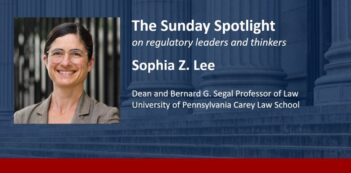
The adaptability of the goals pursued in an agency’s organic statute influences the agency’s response to climate change.
When Congress creates administrative agencies to address social problems, it cannot envision all of the circumstances in which they may be called on to exercise their delegated statutory authority. Indeed, the recognition that agencies will address questions on which Congress lacks expertise or experience is a principal reason for delegating regulatory or management authority to them in the first place. Some agencies are embedded in a legal infrastructure that is better situated to accommodate to changed conditions or novel problems than others, however. The adaptability of the goals that Congress sets out in an agency’s organic statute can either facilitate or doom that agency’s efforts to effectuate programmatic goals in the face of change.
We call this adaptability legal adaptive capacity, meaning the formal legal regime’s capacity to adapt to new phenomena. For our purposes, this regime comprises rules—such as agency regulations, manuals, plans, and guidance—promulgated by public legal institutions, including legislatures, courts, and administrative agencies. Legal adaptive capacity does not refer to other factors, such as resource constraints or agency culture, which may nonetheless influence the adaptive capacity of a regulatory regime.
Law can facilitate (or hamper) adaptation through both substantive and procedural means. We focus on substantive legal adaptive capacity, which we define as the degree to which statutory or regulatory goals are capable of accommodating change. An agency with a high degree of substantive legal adaptive capacity has the authority to adjust its interpretation of regulatory goals or the means of pursuing them, so as to meet new challenges or accommodate changed circumstances. A program with limited substantive legal adaptive capacity has relatively rigid goals that do not allow the agency to alter its regulatory or management approach, notwithstanding changed conditions. Substantive legal adaptive capacity thus measures the extent of elasticity in regulatory or management goals. Accordingly, two regulatory regimes may have similar levels of substantive legal adaptive capacity but nonetheless different regulatory goals.
To illustrate the value of the concept of legal adaptive capacity, consider the extent to which the four principal federal land management agencies—the National Park Service, U.S. Fish and Wildlife Service, U.S. Forest Service, and Bureau of Land Management—have taken actions to prepare for the effects of climate change on the lands and resources that they manage, including wilderness areas under the Wilderness Act of 1964. Contrary to conventional wisdom—which is largely focused on the degree of an agency’s so-called commitment to conservation—the pacesetter in climate change adaptation among the land management agencies has been the Forest Service, followed by the Fish and Wildlife Service. The Bureau of Land Management generally appears to be the agency least ready to minimize the impacts of climate change, though wilderness areas across all agencies are the least prepared.
We believe that part of the explanation for the Forest Service’s demonstrated leadership in this area is the degree to which its organic statute, the National Forest Management Act of 1976, provides expansive substantive legal adaptive capacity. The statute’s focus on long-term ecological sustainability and diversity establishes a broad but not overly specific resource management goal—management for multiple uses and sustained yield.
The National Park Service, by comparison, operates under longstanding regulatory interpretations that require it to preserve resources in their historical conditions and minimize the degree of human intervention with nature. These instructions are notably ill-suited to adapting the agency’s management approaches to climate change, given the unprecedented changes climate change has already begun to invoke as well as its resulting natural resource impacts. Even if the Park Service were fully committed to adapting to climate change, therefore, its substantive legal adaptive capacity would hinder its ability to do so by tethering it to resource conditions that may become impossible to sustain.
The organic legislation and promulgated regulations for the national wildlife refuges provide a moderate degree of flexibility in selecting management goals and the means to achieve them, situating the Fish and Wildlife Service as refuge manager somewhere between the Forest Service and the Park Service in both the degree of substantive legal adaptive capacity and the progress it has made in preparing for climate change.
The outlier is the Bureau of Land Management, which has substantive legal adaptive capacity similar in scope to the Forest Service’s, but which has done the least to address climate change. The absence of clear and enforceable directives to exercise substantive legal adaptive capacity may partially explain the difference between Bureau of Land Management and Forest Service adaptation. But beyond possessing legal adaptive capacity, the agency must also be willing to exercise the discretion it has been afforded. Agency traditions, culture, and resource constraints—to name just a few factors—may hinder it from doing so. Thus, although the Bureau has sufficient legal adaptive capacity to address climate change, its organic statute does not require it to exercise that authority, and the agency has been slow to do so.
More broadly, we recognize that expanding substantive legal adaptive capacity involves tradeoffs, and greater agency pliability may not always be desirable. In the federal lands context, however, the tradeoffs strongly point toward enhancing the four agencies’ substantive legal adaptive capacity because doing so is more likely to promote ecological health than adherence to the historical and noninterventionist values that federal land conservation laws also express. .
Mandating the advancement of, and periodic re-assessment against, a flexible goal—such as the promotion of ecological health in light of changing conditions—may maximize the chance for effective adaptation to change rather than impede it.
This essay draws on Professors Glicksman and Camacho’s article, Legal Adaptive Capacity: How Program Goals and Processes Shape Federal Land Adaptation to Climate Change, which was recently published by the University of Colorado Law Review.





